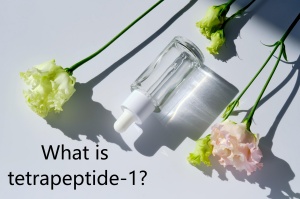What is tetrapeptide-1?

Tetrapeptide-1 is a synthetic peptide composed of four amino acids, commonly used in skincare for its soothing, anti-inflammatory, and protective properties. It is often included in formulas designed to improve skin resilience, reduce sensitivity, and combat environmental damage. This peptide has gained popularity in both cosmeceutical and dermatological products due to its ability to support the skin barrier and modulate inflammatory responses.
Chemical Structure and Function
Tetrapeptide-1 consists of a short chain of amino acids, typically alanine, glutamic acid, glycine, and serine. These peptides are designed to mimic natural body signals that regulate skin processes such as inflammation and cellular repair. Its small size allows it to penetrate the outer layers of the skin efficiently and exert its effects at a cellular level.
Mechanism of Action
Tetrapeptide-1 functions primarily by binding to specific receptors in skin cells, helping to downregulate inflammatory pathways triggered by external stressors such as UV rays and pollution. It also helps promote the release of soothing molecules like beta-endorphins, which can reduce redness and irritation.
Skincare Benefits
The peptide is widely used in skincare for its calming effects, making it suitable for sensitive skin. It also supports skin regeneration and enhances the skin’s ability to withstand external aggressors. Tetrapeptide-1 is commonly paired with other soothing ingredients like panthenol and madecassoside to create highly effective formulas.
Anti-Inflammatory Properties
By inhibiting pro-inflammatory mediators, Tetrapeptide-1 reduces swelling, irritation, and redness. This makes it particularly useful in products formulated for conditions such as rosacea, acne-prone skin, and post-procedural recovery.
Skin Barrier Reinforcement
Regular use of Tetrapeptide-1-containing products can help reinforce the skin’s natural barrier. This reduces transepidermal water loss and improves hydration, which is critical for maintaining healthy skin function over time.
Common Uses in Formulations
Tetrapeptide-1 is used in serums, creams, facial masks, and even after-sun care. It is suitable for both daytime and nighttime use and integrates well into existing skincare routines. Products often target users looking to calm reactive skin or recover after intensive skin treatments.
Combination with Other Peptides
It is often included in peptide complexes, where it works synergistically with peptides like palmitoyl tetrapeptide-7 or acetyl hexapeptide-8. This combination approach can enhance its anti-aging and protective benefits.
Ideal Concentrations and Use
Most products use Tetrapeptide-1 at concentrations between 0.5% and 2%. It should be applied on clean skin, followed by moisturizer and sunscreen during the day. When used consistently, users may notice improvements in skin texture, tone, and sensitivity levels.
Safety Profile and Limitations
Tetrapeptide-1 is considered safe and well-tolerated for topical use. It has low allergenic potential and is non-toxic, making it appropriate for long-term use. However, like any active ingredient, results vary depending on skin type, product formulation, and usage consistency.
Who Should Use It
This peptide is especially recommended for people with sensitive, easily irritated, or environmentally stressed skin. It is also a good choice for those undergoing dermatological treatments, such as chemical peels or laser therapy, as it can aid in skin recovery and minimize side effects.


